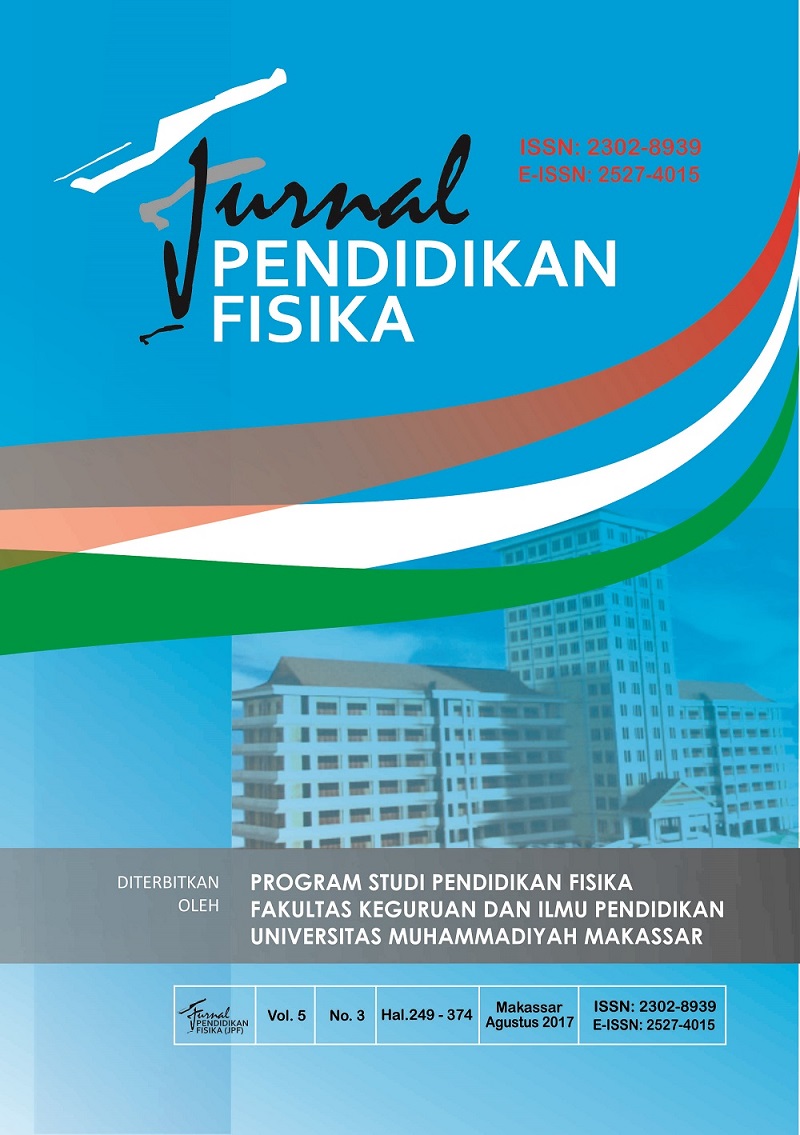Penerapan Scientific Method Di Laboratorium Terhadap Kemampuan Psikomotorik Peserta Didik SMA Negeri 3 Sungguminasa
DOI:
https://doi.org/10.26618/jpf.v5i3.858Abstrak
Penelitian ini merupakan penelitian pra eksperimen dengan desain one-group-pretest-posttest-design yang bertujuan untuk (1) mengetahui kemampuan psikomotorik peserta didik kelas X1. Ipa 1 SMA Negeri 3 Sungguminasa Tahun Pelajaran 2016/2017 sebelum diajar dengan menggunakan pembelajaran scientific method (2) mengetahui kemampuan psikomotorik peserta didik kelas X1. Ipa,1 SMA Negeri 3 Sungguminasa Tahun Pelajaran 2016/2017 setelah diajar dengan menggunakan pembelajaran scientific method (3) mengetahui ada tidaknya peningkatan kemampuan psikomotorik peserta didik sebelum dan setelah diajar pembelajaran scientific method. Subjek dalam penelitian ini adalah kelas X1. Ipa1. Teknik pengumpulan data yang digunakan adalah tes kemampuan psikomotorik yang terdiri dari 5 item dalam bentuk essai yang telah divalidasi oleh dua orang validator. Data yang terkumpul dianalisis dengan menggunakan teknik analisis deskriptif dan analisis Gain. Dari hasil analisis deskriptif kemampuan psikomotorik peserta didik kelas X1. Ipa1 SMA Negeri 3 Sungguminasa sebelum diajar dengan menggunakan pembelajaran scientific method diperoleh nilai tertinggi 19, nilai terendah 9, nilai rata-rata 13,85 dan standar deviasi 2,37 Adapun hasil analisis setelah diajar menggunakan pembelajaran scientific method diperoleh nilai tertinggi 24, nilai terendah 10, nilai rata-rata 19,23 dan standar deviasi 2,73. Hasil analisis inferensial menunjukkan bahwa kemampuan psikomororik peserta didik kelas X1. Ipa1 SMA Negeri 3 Sungguminasa Tahun Ajaran 2016/2017 telah mengalami peningkatan.
Kata kunci : Pra-Eksperimen, Kemampuan Psikomotorik, pembelajaran scientific method
This has pra ekperiment research with one –group-pretest-posttest-design with almed (1) to finding the capacity of psychomotor learners classroom X1.ipa1 at SMA Negeri 3 Sungguminasa in 2016/2017 before teaching with learning Active inductive (2) to finding the capacity of psychomotor learners classroom X1.ipa1 at SMA Negeri 3 Sungguminasa in 2016/2017 after teaching with learning scientific method (3) To finding out how increases the capacity of psychomotor before and after teaching with learning scientific method. Subject in this research X1.ipa1 classroom. The data were collected by test the capacity of psychomotor here consist 5 item in essay had been validation by two validator. The collected data were analysx were use descriptive tecnique analysis and gain analysis. From descriptive analysis were teacing with scientific method the capacity of psychomotor. Were collected the higest score 19. Lower score 9, average score 13,85 and deviation standar 2,37. Now analysis were after teaching used scientific method were result the higest 24, lower 10, and average 19,23 and deviation standar 2,73. This inferensisl analiysis the capacity of psychomotor at X1.ipa1 clasroom at SMA Negeri 3 Sungguminasa in 2016/2017 were increasing.
Keywords : Pre-Experiment, the capacity of psychomotor , Learning scientific method
Referensi
Mahmudin. 2007. Membentuk karakter dan produktif melalui siklus belajar. (online), (http://mahmuddinwordpress.Com/2007/11/09membentuk karakter kreatif-dan-produktif-melalui-siklus-belajar.html, diakses 13 juni 2012).
Abdul sani,Ridwan. 2013. Inovasi Pembelajaran. Jakarta : Bumi Aksara
Ahmadi, Abu & Supatmo. 2008. Ilmu Alamiah Dasar. Jakarta : Asdi Mahasatya
Yaumi, Muhammad. 2013. Prinsip-prinsip Desain Pembelajaran disesuaikan dengan Kurikulum 2013. Jakarta : Kencana
Hendriyan. 2013. Analisis Kemampuan Psikomotorik Siswa Pada Pembelajaran Hands On Tenik Callenge Exploration Activity pada Siswa Muhammadiyah 4 Cipondoh. Skripsi. FITK UIN Syarif Hidayatullah : Jakarta
Sudrajat, Akhmad. 2008. Pembelajaran dan Penilaian Psikomotorik (Depdiknas). (Blog di WordPress.com. The Responsive Theme, diakses 4 Juni 2016.)
Sakti, Indra. 2011. Korelasi Pengetahuan Alat Praktikum Fisika dengan Kemampuan Psikomotorik SiswaSMA Negeri q Kota Bengkulu. Jurnal. JPMIPA FKIP UNIB
Dahniar. Pertumbuhan Aspek Psikomotorik dalam Pembelajaran Fisika Berbasis Observasi G ejala Fisis pada Siswa SMP. Jurnal. Guru sains Fisika SMP Nasional KPS. Balikpapan
Sugiyono. 2009. Metode Penelitian Pendidikan. Bandung: Alfabeta
Hake, Richard. 2002. Analyzing Change/ Gain Scores. (http://list.asu.edu), diakses 01 Juni 2016.
Unduhan
Diterbitkan
Terbitan
Bagian
Lisensi
Copyright:
Authors who publish with this journal agree to the following terms:
1. Authors retain copyright and grant the journal right of first publication with the work simultaneously licensed under a Creative Commons Attribution-ShareAlike 4.0 International License that allows others to share the work with an acknowledgement of the work's authorship and initial publication in this journal.
2. Authors are able to enter into separate, additional contractual arrangements for the non-exclusive distribution of the journal's published version of the work (e.g., post it to an institutional repository or publish it in a book), with an acknowledgement of its initial publication in this journal.
3. Authors are permitted and encouraged to post their work online (e.g., in institutional repositories or on their website) prior to and during the submission process, as it can lead to productive exchanges, as well as earlier and greater citation of published work.
Licence:
Authors are free to:
1. Share: Copy and redistribute the material in any medium or format
2. Adapt: Remix, transform, and build upon the material for any purpose, even commercially.
The licensor cannot revoke these freedoms as long as the authors follow the license terms, which include the following:
1. Attribution: You must give appropriate credit, provide a link to the license, and indicate if changes were made. You may do so in any reasonable manner, but not in any way that suggests the licensor endorses you or your use.
2. ShareAlike: If you remix, transform, or build upon the material, you must distribute your contributions under the same license as the original.
3. No additional restrictions: You may not apply legal terms or technological measures that legally restrict others from doing anything the license permits.
Jurnal Pendidikan Fisika is licensed under a Creative Commons Attribution-ShareAlike 4.0 International License.

